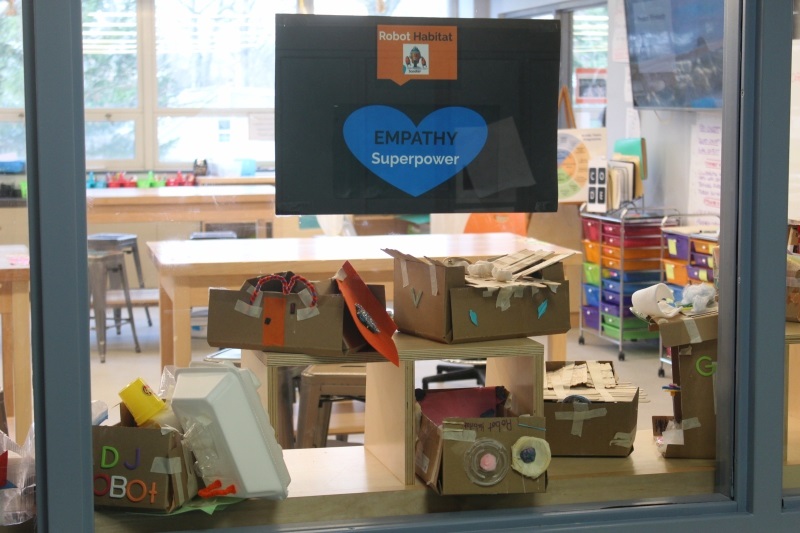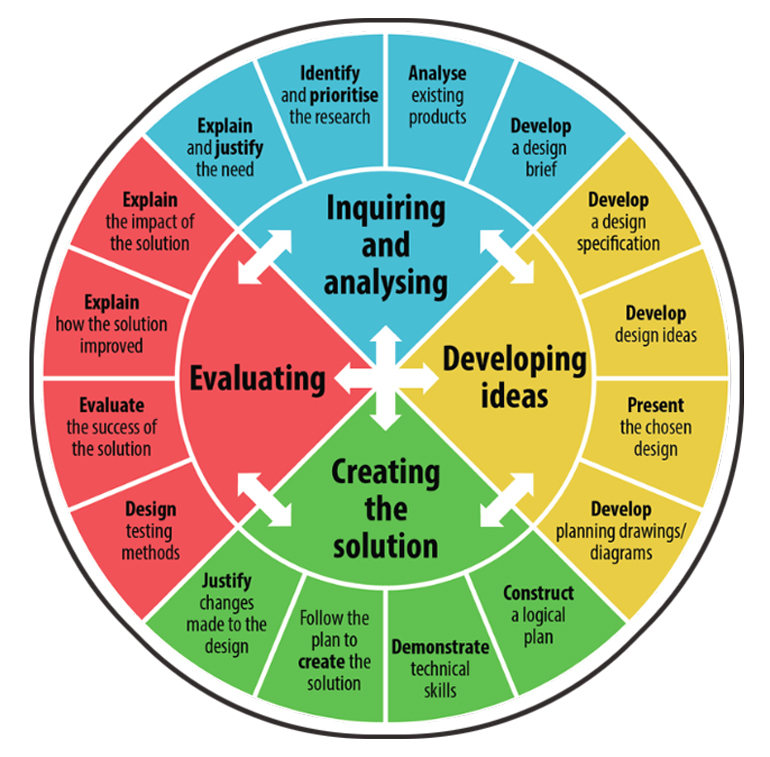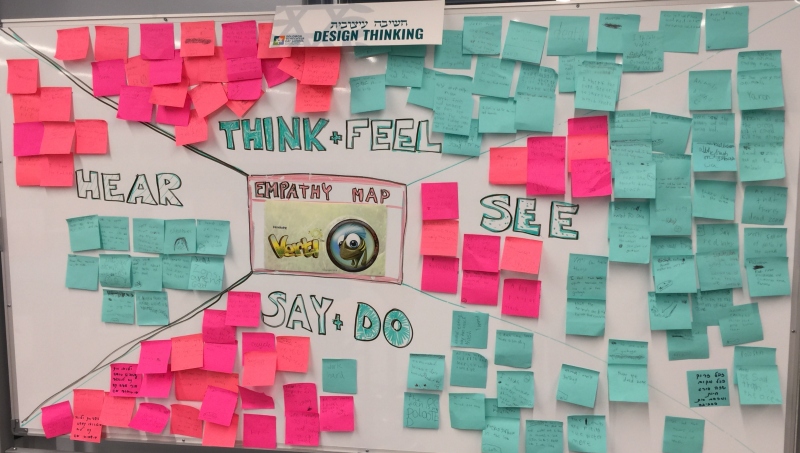Innovation Lab Brings Design Thinking to School
At Solomon Schechter Day School of Bergen County, NJ, the Popkin Innovation Lab has brought a new curriculum and problem-solving approach, along with a different culture, to school this year.
It’s impossible to walk down the hall at Solomon Schechter Day School of Bergen County, NJ, and not peek into the Popkin Innovation Lab.
Projects in progress are visible through a window from the hallway. Inside the lab, students can be seen out of their seats, collaborating on the day’s activity, as a teacher moves around the room. Maybe they’re playing a game of Disruptus—where there is no judgement and innovation is born of “disruptive thinking”—or building robot prototypes with toothpicks and mini-marshmallows. Perhaps they are sharing journal entries of the day’s failures and successes, or filming in front of the green screen.
 |
View from the hallway into the Popkin Innovation Lab. |
Finding the teacher can be a game in itself. Here’s a tip: Don’t look to the front of the room.
“We don’t have a teacher’s desk,” says Roberta Brandão, director of the POP, as it is known at Solomon Schechter, and one of its teachers. “It’s a circular pattern. We often reconfigure [the space] if we need to. It’s more like an orchestra. The teacher is the conductor.”
The teacher is also one of the learners in this new world, finding answers along with the students.
“The old standing-on-a-stage model of teaching is done,” says Andrew Katz, director of academic affairs and interim middle school principal. “We’re trying to get kids to understand that the teacher may not know the answer...so we have to all work together to be able to solve it. When you think about where education is going, [it’s] this type of space and this type of curriculum.”
The POP, which opened this year, has three separate spaces: media, design, and machines rooms. Careers of the future—and the problem-solving employees that companies will need—motivated the lab’s creation.
The media room houses filming and editing equipment and a green screen. Work tables are found in the design and brainstorming areas, where much of the classwork gets done. The machine room has a button maker, laser and vinyl cutters, and sewing machines in the near future.
The POP is not only home to three separate spaces but also three kinds of thinking: design, creative, and computational. But design dominates all for Brandão.
“STEM, STEAM, everything comes from design,” says Brandão.

Sam Seidel is the director of K12 Lab strategy and research at the Stanford d.School, also known as the Hasso Plattner Institute of Design. Part of the K12 Lab program is the School Retool program, a professional development fellowship that helps school leaders “redesign school culture.” The program offers "small, scrappy experiments" not huge, costly overhauls of curriculum and programming.
“Over the last three years, over 800 school leaders have participated in our School Retool fellowship, through which they utilize aspects of design thinking to transform their school culture with the goals of increasing equity and deepening learning,” Seidel says. “Except for a tiny number of extremely privileged students, children in schools today will need to think critically, be creative, and work together in order to be able to buy food and pay their heat bills. Many of the jobs that will exist when they graduate—especially the more financially and holistically rewarding jobs—will require these competencies, but there will not be enough of those jobs, so young people will also need those competencies to create new opportunities.”
For students, design thinking can be a fun and freeing new way to learn. At Solomon Schechter, a K–8 private school, third through eighth graders have class in the lab multiple days a week. While working on long-term interdisciplinary projects, they learn to collaborate and find multiple paths to a solution. The students develop working styles that that, Katz says, corporations want from employees.
“We used to be able to teach kids discreet skills, and they could take those skills and translate that to success in the wider world,” Katz says. “What’s really important [now] is kids being able to identify and frame a problem and figure out how to solve it pulling in a wide variety of skills, chief among that is the idea around being able to be creative and flexible and work collaboratively.”
STEAM with a story
While the concepts and goals may sound complex, Brandão—whose career path took her from computer graphics in animation, film, and video games to psychology and education—knows the key.
“I’m teaching robotics to third grade, but we’re following a story,” she says. “If you can create a context for students, create a narrative arc, it is a game changer.”
For her third graders, this year is extra exciting. They are a focus group for a project for The Disruptive Factory, a company developing an animated series on sustainability called “Verti.”
“Everything we do here is human-centered designed,” says Brandão. “It begins with empathy, to understand the needs of the user, and ends with a tailor-made solution.” Verti is trying to save his planet from pollution and an evil consortium. The students watched a video on pollution and wrote down how Verti would feel and respond to what they learned from the documentary. This is the inquiry and analysis phase, Brandão says. They later used the brainstormed responses to find to Verti’s problem.

Empathy, understanding, and individualism weren’t always keys to problem solving in schools, which historically have taught that there’s only one right answer.
“Students who get to practice design thinking in school get to exercise their muscles in navigating ambiguity, synthesizing complex data, generating and testing ideas, and communicating deliberately,” says Seidel. “Ultimately, they will have empathy for others and confidence in their own creative power—two crucial ingredients for surviving and thriving as individuals and as a species.”
The year-end goal for Brandão’s third graders is a robot that senses, thinks, and acts to help Verti make others empathetic to his environmental cause.
“In design thinking, it’s all about iterations,” says Brandão.
 First there was a drawing, then ScribbleBots. Next, a marshmallows-and-toothpicks prototype. Then they created pods for the robots to live in. Students will build a walking robot that is operated via a button. Finally, they will use littleBits and coding to make a robot that “thinks.”
First there was a drawing, then ScribbleBots. Next, a marshmallows-and-toothpicks prototype. Then they created pods for the robots to live in. Students will build a walking robot that is operated via a button. Finally, they will use littleBits and coding to make a robot that “thinks.”
It’s a big project for the third graders, who can look forward to something even bigger before eighth grade graduation. This year, the eighth graders must create a virtual reality experience to share a personal narrative about something impactful that they learned at the school. They'll write scripts and create a storyboard, use audio clips, footage from 360-degree cameras, drones, and edit on an online VR content editor to create a final product that can be viewed using VR goggles. While this makes a design thinking curriculum appear to be an approach that requires significant funding and would further inequity in education, Seidel says the goal is the opposite.
“Our vision at the d.school K12 Lab is for design thinking to be a force for obliterating inequities in our nation's schools,” he says. “A key part of our work with educators is to help them uncover the roles that racism and other forms of structural oppression play in their schools and more broadly in their students' lives. We ask educators to consider their own identity and positional power and how those things impact their work with students and colleagues.”
Seidel says as part of those efforts, d.school offers materials and trainings for free, as well as adding travel and lodging stipends for educators serving students with financial need.
A new approach
The point, after all, is not the materials used in design thinking but the creative approach to problem solving, something that is typically easier for the younger students.
“We start very creative, and our schooling sucks that out of us,” Brandão says.
 During the early part of the year, Brandão found the older students almost asking permission for their teachers to be creative, to veer off the typical path.
During the early part of the year, Brandão found the older students almost asking permission for their teachers to be creative, to veer off the typical path.
“We talk about failing forward,” says Brandão. “It’s all about learning from their mistakes. I also model that. I make a lot of mistakes.”
And just like in the stories educators at makerspaces around the country consistently share, students that struggle academically elsewhere in school are finding their place in the POP.
“I have the ‘low-achieving’ students being stars and taking leadership roles,” she says.
Doing it right
The students are learning from each other, she says, in ways they don’t in traditional classrooms. While the experience is similar in many ways to a more typical makerspace, the cultural and educational transformation at Solomon Schechter wouldn’t be happening if the POP was an add-on makerspace, according to Katz.
“If you look at other schools that have spaces, it’s often an elective or teachers come when they want, students come when they want,” he says. “That bolt-on approach doesn’t work as well. This is required course for all middle schoolers. It’s as rigorous as a math course and I think that sets the tone for students and faculty.”
For Katz and school administrators, properly using the lab was paramount. To allow time in the POP, the school eliminated electives—most of them were things that would be included in the POP curriculum anyway, such as robotics—and shortened independent study hall periods. The students don’t seem to miss what was lost.
“I get chased by the little kids,” Brandão says, laughing at the difference from when she taught in a high school. “They’re so excited. Parents tell me, ‘I know all about you. They’re talking about design.’”
RELATED
The job outlook in 2030: Librarians will be in demand
The job outlook in 2030: Librarians will be in demand
ALREADY A SUBSCRIBER? LOG IN
We are currently offering this content for free. Sign up now to activate your personal profile, where you can save articles for future viewing






Add Comment :-
Be the first reader to comment.
Comment Policy:
Comment should not be empty !!!